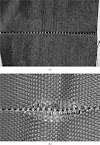Scouring Process in Textile Industry
The main purpose of scouring is to remove natural as well as added impurity of hydrophobic character as completely as possible and leave the fabric in a highly absorptive condition without undergoing physical or chemical damage and also to make the fabric suitable for removing the natural colour in matter of the Cotton during subsequent bleaching process.
Changes taking place during scouring:
• Saponifiable oil in cotton fibre are converted into soaps.
• The unsaponifiable oil and waxes in fibres are emulsified.
• The proteins are hydrolysed into soluble products.
• The pectose and pectin are changed into soluble salts of pectic or meta-pectic acid.
• Simpler amino compounds (protein products) are dissolved or hydrolysed to ammonia.
• Mineral matter is dissolved.
• Dirt particles are removed and held in a stable form in the Kier liquor.
Scouring process
• Lime soda process
1. Dipping the Fabric in [Ca(OH)2] solution.
2. Heating up to 120°C at 1.35 kg/cm² for few hrs.
3. Washing to remove soluble impurities.
4. Keeping / steeping in dil. HCL solution to remove calcium soaps.
5. Washing to remove acid .
6. Boiling with sodium carbonate to remove fatty acids.
7. Hot wash & cold wash.
8. Drying of fabric
• Caustic soda and boil process
1. It is widely used for cotton.
2. Dipping the fabric in caustic soda, soda ash, detergent, wetting agent and Sequestering agent
3. Hitting till boil at 25-30°C.
4. Draining the scouring solution liquor and do the Hot wash and cold wash
5. Drying of fabric
• Kier boiling
1. Kier is a cylindrical vessel, generally vertical capable of holding I to 3 tons of fabric
2. A 2 ton kier having dimensions of 2.7m (9 feet) in height and 1.95 m (6.5 feet) in diameter is commonly use for boiling.
3. Kiers are made up of mild steel blades of 0.6 cm thickness, they are provided with a Pressure gauge & safety valve.
4. It has a hole at the top through which fabric is loaded & unloaded.
5. The inner value of kier is given a layer mixture of lime cement & sodium silicate to avoid formation of rust stains on the fabric.
6. The of grey fabric after desizing is loaded into the kier in rope form by piling it uniformly either by means of an automatic piling as by manual piling.
7. The kier should not be filled beyond 80-85% of its capacity as overfilling may create undue hydraulic pressure which affects on circulation of the liquor.
8. After the material is piled in the kier, heavy stones are placed uniformly on it to prevent it from being tossed up during boiling.
9. High pressure kier operates at about 130°C (2.109 kg/cm 2) for about 8 to 10 hours with a liquor ratio 5:1 to 6:1.
10. After scouring the drain cock is opened at reduced pressure (5 to 6 lb/in 2) and equivalent amount of hot water is admitted from the top.
11. Once the cold water circulation on the goods is done, they are removed and transfer to the rope machine for washing.
12. From the bottom of kier, the withdrawal of the liquor is carried out that is forced through the heater. A distributor is then used to spread over the substrate.












0 Comments
If you have any doubts, please don't hesitate to ask